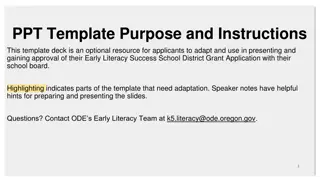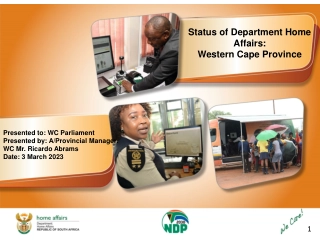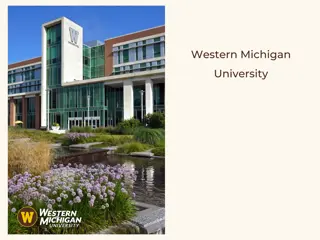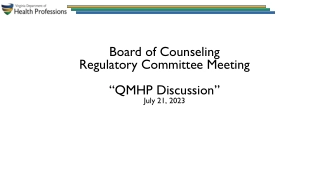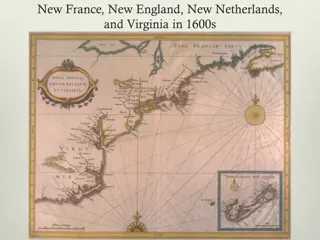Early Explorers in Western Virginia
Exploration of Western Virginia by early adventurers, including Abraham Wood and John Lederer, sheds light on the conflicts between French and English settlers. Discover the challenges and triumphs of these pioneers as they navigated unknown territories and interacted with indigenous peoples, leaving a lasting impact on the region's history.
Early Explorers in Western Virginia
PowerPoint presentation about 'Early Explorers in Western Virginia'. This presentation describes the topic on Exploration of Western Virginia by early adventurers, including Abraham Wood and John Lederer, sheds light on the conflicts between French and English settlers. Discover the challenges and triumphs of these pioneers as they navigated unknown territories and interacted with indigenous peoples, leaving a lasting impact on the region's history.. Download this presentation absolutely free.
Presentation Transcript
Early Explorers in Western Virginia Main Menu
ESSENTIAL QUESTIONS Who were some of the early explorers of western Virginia? What caused the conflict between the French and the English in western Virginia?
The exploration of Virginia, and more specifically western Virginia, occurred a little more than 100 years after the voyages of Christopher Columbus. The first settlement in Virginia was made in Jamestown in 1607. This site was chosen because the settlement could be easily defended and the land was not occupied by Native Americans.
A year after sailing to the new world, Captain Christopher Newport led an expedition from Jamestown, to explore the western lands of Virginia. The mountains of western Virginia were a tremendous barrier to exploration. Therefore, the Europeans investigated routes that would take them through gaps in the mountains or along river valleys.
Early explorers of western Virginia included Abraham Wood a fur trader who commanded Fort Henry near present-day Petersburg, Virginia Wood personally led an expedition into western lands in 1650. The group traveled from Fort Henry to the headwaters of the Roanoke River. The voyage was documented in a pamphlet called The Discovery of New Brittaine. Fort Henry
Later, others crossed western Virginia while exploring new lands. These explorers included John Lederer Abraham Wood Thomas Batts and 1669-1671 1671 1671 Robert Fallam Howard and Salling Thomas Walker 1742 1750
John Lederer First person to enter present-day West Virginia His expedition is sometimes discredited because some believe he sometimes recorded hearsay. his journal account contained references that some think are imaginary. His journal referred to the Atlantick Ocean, which some think actually might have been fog over the Blue Ridge Mountains.
Thomas Batts and Robert Fallam Members of the expedition Found interesting tree markings, M.A.N.I. and MA.NI, which probably meant others had been there before them Thomas Batts (the leader of the voyage) Robert Fallam (kept a journal) Thomas Wood (may have been a relative of Abraham Wood) Penecute (an Appomattox Indian who guided the group) In Monroe County they marked trees with a hot iron to claim their territory Jack Weason (perhaps an indentured servant of Abraham Wood) Marking included: CR for the English King Charles II WB for Virginia governor William Berkeley AW for Abraham Wood TB:RF:P for Thomas Batts, Robert Fallam, and Penecute
James Needham and Gabriel Arthur Traveled from Fort Henry to Tennessee to make an agreement with the Cherokee to end the trade monopoly of the Occaneechi After making a treaty with the Cherokee, Needham returned to Fort Henry while Arthur stayed in Tennessee. Later, when Needham set out to return to Tennessee, he was killed. Sometime later, Arthur went with the Cherokee to Spanish West Florida on a trading mission. On the return voyage, the group passed through Tennessee and western Virginia. They eventually followed the Coal River to a Moneton Indian village near St. Albans. Arthur is believed to be the first European to see the Kanawha River. The importance of the exploration of Needham and Arthur was that it ended the trading superiority of the Occaneechi and Spaniards.
FRENCH EXPLORATION At the same time the English were exploring western Virginia from the east, the French decided to explore the land from the north. Robert Cavalier Sieur de La Salle sailed from the Great Lakes and reached the Falls of the Ohio River, near present-day Louisville, KY. La Salle s expedition gave France a claim to the Ohio Valley Since the English also had a claim to the same area, this would later lead to confrontation and war between the two European powers.
As the French increased their exploration activities in North America, the British temporarily ceased theirs. The English suspended their explorations for a number of reasons, including Virginia lost its main promoter of exploration when Abraham Wood died. Governor William Berkeley angered the colonists when he refused to send troops to protect them from Indian attacks. Bacon s Rebellion resulted in the withdrawal of monetary support from wealthy supporters of the western fur trade in England.
Returned British Interest in Western Exploration In 1716, Alexander Spotswood, lieutenant governor of Virginia, personally led an expedition of thirty aristocrats from Williamsburg, Virginia, across the Appalachian Mountains into the Shenandoah Valley. Along the way, they killed bears, told stories around campfires, and swam in the Shenandoah River. Spotswood described the land they discovered as an agricultural paradise in order to encourage settlement. Williamsburg Spotswood gave each member of his expedition a miniature golden horseshoe. Today a replica of this gift is given to eighth- grade students across West Virginia in honor of their excellence in pursuit of the study of West Virginia History.
The Conflict between the English and the French Intensifies. To gain a stronger claim to the western lands, Virginia Governor William Gooch sent John Howard and John Peter Salling on an expedition through the western lands to the Mississippi River. They crossed the Allegheny Mountains and traveled for a time along the New River. They left the New River and traveled by foot until they came to a smaller, calmer river. As they traveled along that river, they became the first explorers to see coal at Peytona. They named the small, calm river the Coal. They finished their voyage by traveling from the Coal to the Kanawha River and then following the Kanawha to Point Pleasant where they entered the Ohio River. Finally, they traveled on the Ohio River to the Mississippi.
To give the French a stronger claim to western lands, the governor of Canada ordered an expedition to place leaden plates along the Ohio River as proof of their ownership of the land in the area. A plate that was buried at the mouth of the Kanawha River was found by a young boy in 1846. Celoron de Blainville led some 250 men, including a number of Indians, on the expedition.
A New Reason for Exploring By the middle of the 18th century, privately owned land companies began exploring to find land for profit. Two of the most important land companies were The Loyal Land Company The Ohio Land Company employed Christopher Gist, who on a second trip, explored an area bordered by the Monongahela, Ohio and Kanawha rivers. employed Dr. Thomas Walker to explore land that included part of present-day southern West Virginia







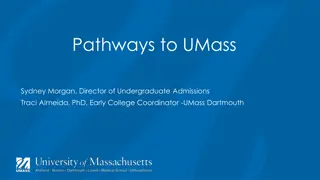





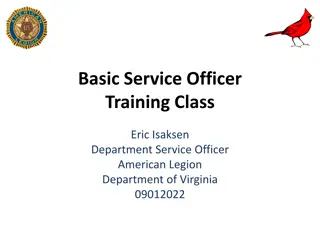







![Read⚡ebook✔[PDF] Linking the Space Shuttle and Space Stations: Early Docking Te](/thumb/21519/read-ebook-pdf-linking-the-space-shuttle-and-space-stations-early-docking-te.jpg)


